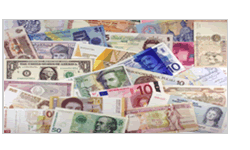By GCI Fx Research
€
The euro moved higher vis-à-vis the U.S. dollar today as the single currency tested offers around the US$ 1.4365 level and was supported around the $1.4255 level. The European Central Bank convenes on Thursday and is not expected to change monetary policy at that meeting. The ECB today released a report that notes there is systemic risk in the credit default swaps market because the ten most active counterparties account for up to 72% of default swap exposure surveyed by lenders. Data released in the eurozone today saw the August consumer price index improve to -0.2% from July’s -0.7% decline. The decrease in disinflationary pressures suggests inflation may increase in the coming months. Recent economic activity in the eurozone has been on the upswing but there is a sizable chance the recent economic improvement could falter. French finance minister Lagarde was on the wire today saying the economies of the eurozone are stabilizing. In U.S. news, data released in the U.S. today saw the August Chicago PMI index print at 50.0, up from the prior reading of 43.4. Also, the New York NAPM activity improved for the first time in three months in August. Recent economic data in the U.S. have been on the upswing and dealers are interested to see if recent housing and and other economic data can continue the uptrend. Euro bids are cited around the US$ 1.3900 figure.
¥/ CNY
The yen appreciated vis-à-vis the U.S. dollar today as the greenback tested bids around the ¥92.55 level and was capped around the ¥93.55 level. As expected, the Democratic Party of Japan won a landslide victory in yesterday’s general election over the long-incumbent Liberal Democratic Party of Japan. The DJP won 308 seats in the lower house of parliament and the LDP’s representation fell to 119 from 300. Traders are carefully assessing the election results to determine how well the DPJ will be able to control spending and manage the government. There is widespread speculation the DPJ will attempt to inflate public spending through new Japanese government bond issuance, possibly increasing social spending. There is also skepticism that the yen’s post-electoral gains will be sustainable. Some believe former Ministry of Finance official “Mr Yen” Sakakibara will get a portfolio in the new government. Data released in Japan overnight saw July construction orders off 42.8% y/y to ¥660.9 billion while July overall housing starts were off 32.1% y/y to 65,974. Other data released tonight saw July wages decline 4.8% y/y while July overall retail sales were off 2.5% y/y. Additionally, July industrial output was up 1.9% m/m. The Nikkei 225 stock index lost 0.40% to close at ¥10,492.53. The euro moved lower vis-à-vis the yen as the single currency tested bids around the ¥132.15 level and was capped around the ¥133.85 level. The British pound moved lower vis-à-vis the yen as sterling tested bids around the ¥132.15 level while the Swiss franc moved lower vis-à-vis the yen and tested bids around the ¥87.20 level. In Chinese news, the U.S. dollar gained ground vis-à-vis the Chinese yuan as the greenback closed at CNY 6.8290 in the over-the-counter market, up from CNY 6.8256. Chinese equities were off more than 6% today and closed at levels not seen since May. It was reported that new yuan loans made by Chinese lenders in August were likely to fall below ¥300 billion from ¥356 billion in July and ¥1.53 trillion in June.
₤
The British pound moved higher vis-à-vis the U.S. dollar today as cable tested offers around the US$ 1.6300 figure and was supported around the $1.6180 level. Bank of England Monetary Policy Committee member Besley reported he sees economic growth returning by the end of the year during a period of “recuperation and recovery.” He added he sees “some sort of growth” in 2009 and 2010. Data released in the U.K. today saw August house prices rise 0.1% m/m, the first rise since July 2007, and were off 6.7% y/y. Cable bids are cited around the US$ 1.6030 level. The euro moved higher vis-à-vis the British pound as the single currency tested offers around the ₤0.8825 level and was supported around the ₤0.8775 level.
Daily Market Commentary provided by GCI Financial Ltd.
GCI Financial Ltd (”GCI”) is a regulated securities and commodities trading firm, specializing in online Foreign Exchange (”Forex”) brokerage. GCI executes billions of dollars per month in foreign exchange transactions alone. In addition to Forex, GCI is a primary market maker in Contracts for Difference (”CFDs”) on shares, indices and futures, and offers one of the fastest growing online CFD trading services. GCI has over 10,000 clients worldwide, including individual traders, institutions, and money managers. GCI provides an advanced, secure, and comprehensive online trading system. Client funds are insured and held in a separate customer account. In addition, GCI Financial Ltd maintains Net Capital in excess of minimum regulatory requirements.
DISCLAIMER: GCI’s Daily Market Commentary is provided for informational purposes only. The information contained in these reports is gathered from reputable news sources and is not intended to be U.S.ed as investment advice. GCI assumes no responsibility or liability from gains or losses incurred by the information herein contained.





